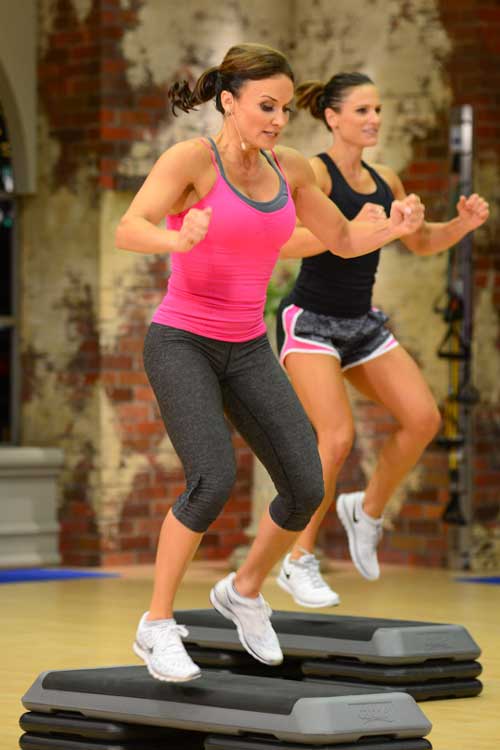You may think of plyometrics as jump training, but that’s a little too restrictive. Throwing medicine balls is also a plyometric exercise. When you look at a plyometric move at the level of the muscle, the movement is divided into three phases. The first is called the eccentric, or loading phase. During this phase, energy is stored as elastic energy within the muscle. The second phase, called the amortization phase, is a short rest period where the stored energy is held in preparation for the final, or concentric phase of the movement. During the concentric phase, the elastic energy stored during the eccentric phase is released, leading to a burst of power.
What’s the purpose of storing energy in elastic tissue and then releasing it explosively like fizz out of a soda can? It’s to develop explosive power. If you think about it, strength training helps you become stronger but it doesn’t make you more powerful. Strength refers to how much force you can generate, independent of time, while power has a time component to it. Power is how QUICKLY you can develop force. If you can move a heavy resistance slowly, you’re strong, but if you can do it fast, you’re powerful.
So, why do you need to be powerful when you don’t play a sport that requires explosiveness? Two reasons. One, engaging in plyometrics can help your weight training performance. Plyometric training trains fast-twitch muscle fibers. These are the fibers you maximally recruit when you lift heavy. Having more efficient fast-twitch muscle fibers works in your favor. Plus, plyometrics improves the elastic properties of muscles so you can handle more intense training safely.
Even more important is how plyometric power training pays off with longer terms benefits. It’s no secret that we lose muscle strength and mass with age, about 30% between the ages of 50 and 70. No wonder sarcopenia is such a common problem in older people! You need muscle not only for strength but for stability to protect you against falling. Plyometrics work the all-important fast-twitch fibers that are the strength and power fibers.
Did you know maintaining power is as important as preserving strength as you age? When you rise from a chair, you not only need strength but power to catapult yourself upwards. Plyometrics help you retain muscle power as you age by building fast-twitch muscle fibers and by strengthening the nervous system connection between brain and muscle.
There’s another benefit to doing plyometrics too. Jumping is a high-impact exercise that helps preserve bone density. As you know osteoporosis is one of the most common age-related problems women experience. High-intensity weight training and high-impact exercises like jumping are among the most effective ways to preserve body density.
The Wonderful World of Plyometric Drills
How can you get started with plyo training? If you’re new to plyometrics, start by doing exercises like jump squats. You can even incorporate plyo moves into weight training. For example, after doing leg squats (a strength exercise), follow up with a plyometric exercise (without weights) that’s similar like jump squats. This is called contrast training.
You’ve probably seen people jumping on and off a bench. That’s a form of plyo training too. Start by using a low bench until you’ve mastered the technique. Be aware that the risk for injury is higher with plyometrics than with exercises.
Avoiding Injury
A word of caution. If you’re over the age of 50 and you’ve never done plyometrics, start slowly. Tendons lose some of their elasticity with age, and if you approach plyometrics too aggressively, in the beginning, you risk a tendon injury.
Don’t do plyometric drills every day. Stick to two to three times a week at most and don’t try to do cardio on the same day. Keep the volume low, no more than 3 or 4 plyometric drills at first and gradually work up to the point you’re doing a total of five or six plyometric drills. Since plyometric drills get your heart rate up, you can use them as a substitute for cardio on some days.
You can also add a few plyometric drills to the end of a workout as a “finisher.” Don’t forget that plyometric drills aren’t just for your lower body. You can build explosive power in your upper body by doing plyometric push-ups where you push yourself off the ground with force during the rising phase of the push-up. Start by doing them on your knees and gradually work up to performing them on your toes. They’re considerably more challenging than standard push-ups. Medicine ball throws are another plyometric move that builds upper body power. Your core and trunk can even get in on the action if you do plyometric sit-ups.
Always Warm-Up Beforehand
Because the risk for injury is higher with explosive movements like plyometrics, make sure your muscles are warm before attempting the first drill. Jogging in place, lateral shuffle drills, and jumping jacks are good ways to warm up and get the blood flowing to your muscles. Form is critical too. When you land from a jump, your knees and shoulders should be aligned when viewed from the side. If you’re jumping on and off a platform choose a sturdy one that has sufficient surface size. Be sure you’re wearing shoes that have good arch and side support.
The Bottom Line
Plyometric training is one of the best ways to build explosive power but do it safely. By including plyometric drills in your training, you’ll develop greater power that will help you stay functional as you age.
References:
FreeLap. “Electronic Timing for Speed Development”
Sports Science Lab. “Plyometrics”
Berkeley Wellness. “Sarcopenia: Muscle Loss from Aging”
Strength and Conditioning Research. “Power”
Related Articles By Cathe:
How Plyometric Exercises Can Benefit Your Fitness Routine
Related Cathe Friedrich Workout DVDs:


